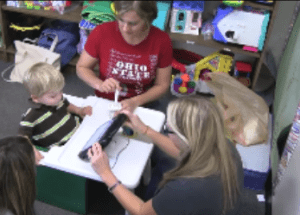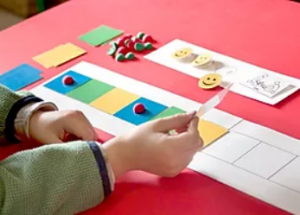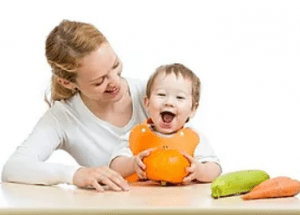Listed below are daily exercises to do with your child. Don’t try to implement everything at once. Instead, pick one of these things you think you can do, and try it for a week. Once it becomes a habit, add something else.
Birth to 2 Years
- Pronouncing sounds like “ma,” “da,” and “ba.” Try to get your baby to say them back to you.
- Look at your baby when he makes sounds. Talk back to him, and say what he says. Pretend to have a conversation.
- Respond when your baby laughs or makes faces. Make the same faces back to her.
- Teach your baby to do what you do, like clapping your hands and playing peek-a-boo.
- Talk to your baby as you give him a bath, feed him, and get him dressed. Talk about what you are doing and where you are going. Tell him who or what you will see.
- Point out colors and shapes.
- Count what you see.
- Use gestures, like waving and pointing.
- Talk about animal sounds. This helps your baby connect the sound and the animal. Use words like “The dog says woof-woof.”
- Read to your child.
2 to 4 Years
- Model good speech.
- Repeat what your child says to show that you understand.
- It’s okay to use baby talk sometimes. Be sure to use the adult word too. For example, “We will have dinner now.”
- Help your child understand and ask questions. Play the yes–no game. Ask questions such as, “Are you Marty?” and “Can a pig fly?” Have your child make up questions and try to fool you.
- Ask questions that include a choice. “Do you want an apple or an orange?” “Do you want to wear your red shirt or your blue shirt?”
- Help your child learn new words. Name body parts, and talk about what you do with them. “This is my nose. I can smell flowers, brownies, and soap.”
- Sing simple songs, and say nursery rhymes. This helps your child learn the rhythm of speech.
- Place familiar objects in a box. Have your child take one out and tell you its name and how to use it. “This is my ball. I bounce it. I play with it.”
- Show pictures of familiar people and places. Talk about who they are and what happened. Try making up new stories.
4 to 6 Years
- Pay attention when your child talks to you.
- Get your child’s attention before you talk.
- Praise your child when she tells you something. Show that you understand her words.
- Pause after speaking. This gives your child a chance to respond.
- Talk about where things are, using words like “first,” “middle,” and “last” or “right” and “left.” Talk about opposites like “up” and “down” or “on” and “off.”
- Have your child guess what you describe. Say, “We use it to sweep the floor,” and have her find the broom. Say, “It is cold, sweet, and good for dessert. I like strawberry” so she can guess “ice cream.”
- Work on groups of items, or categories. Find the thing that does not belong in a group.
- Help your child follow two- and three-step directions. Use words like, “Go to your room, and bring me your book.”
- Ask your child to give directions. Follow his directions as he tells you how to build a tower of blocks..
- Use everyday tasks to learn language
- Go grocery shopping together. Talk about what you will buy, how many things you need, and what you will make. Talk about sizes, shapes, and weight.







